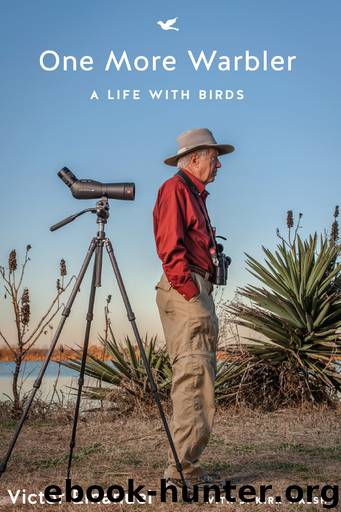One More Warbler by Victor Emanuel

Author:Victor Emanuel [Emanuel, Victor]
Language: eng
Format: epub
Publisher: University of Texas Press
Published: 2017-03-09T16:00:00+00:00
13
The Next Generation of Birders
Magnificent Hummingbird
CHIRICAHUA MOUNTAINS
CAVE CREEK CANYON, ARIZONA
In 1978, Rose Ann Rowlett was in charge of organizing a hawk watch in September outside of Corpus Christi. This hawk watch has evolved into one of the largest events of its kind in the country, with a wide array of hawks—Mississippi Kites, Broad-winged, Swainson’s, Sharp-shinned, and Cooper’s Hawks—flying over the region during the early fall months. Within the peak period of the hawk migration, thousands of raptors are counted as they travel from Canada to tropical destinations. Some, such as the Swainson’s Hawk, migrate all the way to Argentina. In the 1978 watch, about thirty or so observers were stationed at different points along a twenty-mile, east-west stretch of land, spending the entire day at their designated post, counting the hawks that flew overhead, and identifying them.
Rose Ann assigned me to a spot called Fort Lipantitlán, a wooden-picket structure that was built around 1831 by the Mexican forces in anticipation of trouble with Anglo immigrants. The fort was named after a camp of Lipan Apaches in the vicinity. Nothing remains of this fort.
I arrived at eight o’clock in the morning. Hawks don’t start flying until the thermals begin rising around nine or ten o’clock in the morning. Shortly thereafter, a car driven by David Braun arrived and three young birders—Kurt Huffman, David Sugeno, and Peter English—got out. I soon learned that these boys had met as students at St. Stephen’s Episcopal School in Austin and discovered their mutual passion for birds. Kurt and David were thirteen years old, and Peter, twelve. We spent the day counting hawks. We didn’t see many, but we had a good time together. These young birders, with their boundless enthusiasm for birds and nature, reminded me of the way I was at their age. During this hawk watch, I recognized that spending time and birding with these three young boys offered an opportunity to be a mentor, just as Armand, Joe, and Edgar had been mentors to me. Also like my own mentors, I didn’t have children, so I had the extra time to spend with these boys.
After the hawk watch, I stayed in touch with Kurt, David, and Peter and took them to monthly Travis Audubon Society meetings. We also did some birding around Austin, particularly at the Hornsby Bend Sewage Treatment Plant and the South Austin Sewage Treatment Plant. One day, a few years later, the trio appeared at my house in the Travis Heights neighborhood to tell me the exciting news that they had discovered a Long-tailed Duck at the South Austin Treatment Plant. They took me to see this duck, a species that is very seldom observed around Austin. On another occasion, Kurt, Peter, and I drove to a spot south of Luling to observe a Northern Jacana, a tropical shorebird that is very rarely seen in the United States. Chestnut-colored with a black neck, head, and breast, and a yellow bill, the Northern Jacana has long, slender toes that allow it to walk on water hyacinths and lily pads.
Download
This site does not store any files on its server. We only index and link to content provided by other sites. Please contact the content providers to delete copyright contents if any and email us, we'll remove relevant links or contents immediately.
| Excursion Guides | Field Guides |
The Lonely City by Olivia Laing(4774)
Animal Frequency by Melissa Alvarez(4431)
All Creatures Great and Small by James Herriot(4277)
Walking by Henry David Thoreau(3926)
Exit West by Mohsin Hamid(3797)
Origin Story: A Big History of Everything by David Christian(3668)
COSMOS by Carl Sagan(3593)
How to Read Water: Clues and Patterns from Puddles to the Sea (Natural Navigation) by Tristan Gooley(3434)
Hedgerow by John Wright(3322)
How to Read Nature by Tristan Gooley(3295)
The Inner Life of Animals by Peter Wohlleben(3286)
How to Do Nothing by Jenny Odell(3269)
Project Animal Farm: An Accidental Journey into the Secret World of Farming and the Truth About Our Food by Sonia Faruqi(3194)
Origin Story by David Christian(3170)
Water by Ian Miller(3159)
A Forest Journey by John Perlin(3046)
The Plant Messiah by Carlos Magdalena(2903)
A Wilder Time by William E. Glassley(2838)
Forests: A Very Short Introduction by Jaboury Ghazoul(2815)
